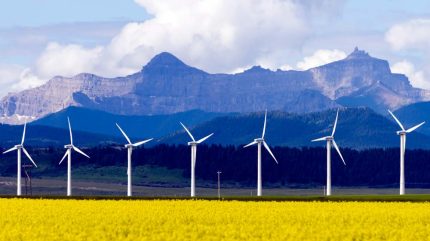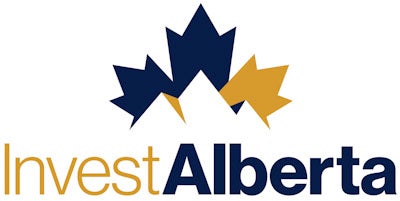
The issue of energy security has been brought into sharp focus in recent years given geopolitical conflicts and widespread supply chain disruption.
Canada’s western-most province Alberta has a strong history of oil and gas expertise and is now rapidly becoming a powerhouse in green solutions. This diverse energy mix is protecting against supply chain disruption and strongly positions the province to achieve its ambition of being carbon neutral by 2050.
The clean energy future is taking shape. Two hours south-east of Calgary, Alberta’s most populous city, is Canada’s largest solar power project, Travers Solar. The project has more than one million solar panels and a capacity of 465MW.
Alberta has also seen a huge influx of investment in wind power generation. Last year, Canada’s largest onshore wind farm, the 494MW Buffalo Plains Wind Farm, began delivering power to the Alberta grid. The facility has the capacity to power around 140,000 homes. Amazon has a major stake in both the Buffalo Plains Wind Farm and the Travers solar farm as evidence of the international appeal of Alberta’s clean energy sector.
Alongside this, all coal generation in the province has been decommissioned five years ahead of schedule. As the reliability and resilience of power systems come under increasing scrutiny, Alberta is proof that the energy transition can be undertaken effectively, mitigating the risk of supply instability.
“Energy independence is a real possibility for Alberta because of its secure foundation in fossil fuels and strength in emerging renewable power and biofuels sectors. As the energy transition progresses, the province must also ensure a stable flow of power for Albertans,” says Meghan Butler, Director of Investment Attraction, Energy, at the province’s economic development agency Invest Alberta.
Meeting soaring energy demand for electricity in tech
Against the backdrop of the energy transition, the expansion of electricity demand from tech places a further strain on grid supplies globally. Cloud-computing, the internet of things and AI form the foundations of 21st century growth and are rapidly driving up energy consumption.
The challenge of expanding low and zero emission energy sources without risking blackouts or cost volatility has been described by the International Energy Agency (IEA) as the “energy trilemma”. However, Butler says Alberta’s energy diversity mix, including its world-class oil and gas infrastructure and long history in hydrocarbons, offers the critical stability for businesses looking to expand while the new energy solutions mature.
“We have the engineering expertise, infrastructure, and regulatory framework to power a diverse energy economy. Alberta’s energy security strategy is one of addition, not replacement, combining the province’s natural resource advantage with renewables development to assure energy supply,” adds Butler.
Initiatives to deliver grid stability in Alberta
The energy growth strategy in Alberta is ensuring that investors in the province do not have to worry about access to stable and affordable power.
The provincial government is committed to removing as many barriers as possible to attract capital flows, including being able to accommodate the heightened electricity demand of data centres.
Natural gas provides reliable baseload generation to ensure the grid remains stable while supporting the co-development of wind and solar projects. The balanced mix keeps prices competitive and reinforces Alberta’s position as Canada’s lowest-cost energy provider.
The opportunity for cogeneration is expanded through natural gas, particularly for data centre operations. Cogeneration uses natural gas to generate electricity and heat energy. The heat produced by burning natural gas can be repurposed to drive absorption chillers to prevent servers and other equipment from overheating. This alternative use of waste heat is an innovative way to mitigate emissions, while providing another alternative energy source in Alberta.
The advantages of combining hydrocarbons and renewables in energy supplies
A carbon-neutral oil and gas industry is not possible without effective carbon capture, utilisation and storage (CCUS) capabilities. CCUS is widely regarded as one of the most effective solutions to reduce emissions in hard-to-abate sectors and is a key priority in Alberta, leveraging the unique geology of the Western Canadian Sedimentary Basin.
Two of the world’s largest CCUS projects are based in Alberta – the Alberta Carbon Trunk Line (ACTL) and Shell’s Quest project – and many more are in the pipeline. This makes sense given the province has capacity in its saline aquifers and oil and gas reservoirs estimated to top 100 billion tonnes of CO2. The Alberta Government is actively supporting CCUS development by working with industry to develop an optimal policy framework for growth in a sector that has high capital costs and requires certainty amid long-term planning.
Measures include offering tax credits combined with financial support through initiatives such as the Alberta Carbon Capture Incentive Program (ACCIP), the Clean Resource Innovation Network and Emissions Reduction Alberta, which draws from Alberta’s Technology, Innovation and Emissions Reduction (TIER) fund.
One CCUS project of note in the works is being brought forward by Pathways Alliance, a consortium of Alberta’s largest oil sands companies, aiming to capture and store ten million tonnes of CO2 annually through a 400km pipeline to a storage hub near the Cold Lake region. Planned for operation by 2030, this large-scale carbon capture and storage network would be the world’s largest and set a new benchmark in global CCUS projects. Once complete, the project could reduce oil emissions by 22 megatonnes a year by 2030 – the equivalent of taking 90% of all cars and trucks off the road in Alberta.
The project is currently one of 22 sequestration hub proposals being actively considered for development by the Alberta Government. As a result, other innovators in the carbon capture space are also being attracted to Alberta. One example is a company called Deep Sky, which has just opened a direct air capture and commercialisation facility in a world-first. Deep Sky’s project Alpha considerably advances carbon removal technology to create a new economic opportunity in Alberta. Crucially, Deep Sky Alpha runs on 100% solar energy, with carbon sequestered 2km underground.
Earlier this year, Emissions Reduction Alberta announced a C$5m funding support package through TIER to help Deep Sky make its decarbonisation innovations a reality.
How collaborations are delivering industry advances in Alberta
Collaborations between different industries are crucial to delivering progress in energy security in Alberta. For example, CCUS infrastructure investment is driving the potential of clean hydrogen in Alberta. The Calgary Region Hydrogen Hub is an initiative aiming to unite startups, industry, researchers, and investors and drive large-scale hydrogen fuel cell adoption in the region and beyond. The hub opened in June and is the second such initiative in the province.
Businesses in Alberta can benefit from collaborations with universities to not only drive further innovation but also build the next generation of skilled workers from a population younger than any other Canadian province.
“Alberta is building on its strong foundations as an energy powerhouse. Our expertise in oil and gas, carbon capture and hydrogen, as well as wind and solar means we are rapidly becoming one of the most investable energy jurisdictions in the world,” adds Butler. “In a market hungry for secure, sustainable energy, as well as a stable political landscape and workforce skills, Alberta is delivering.”
To learn about Alberta’s strategy for data centres and how to meet the considerable energy requirements, download the specially commissioned report below.



